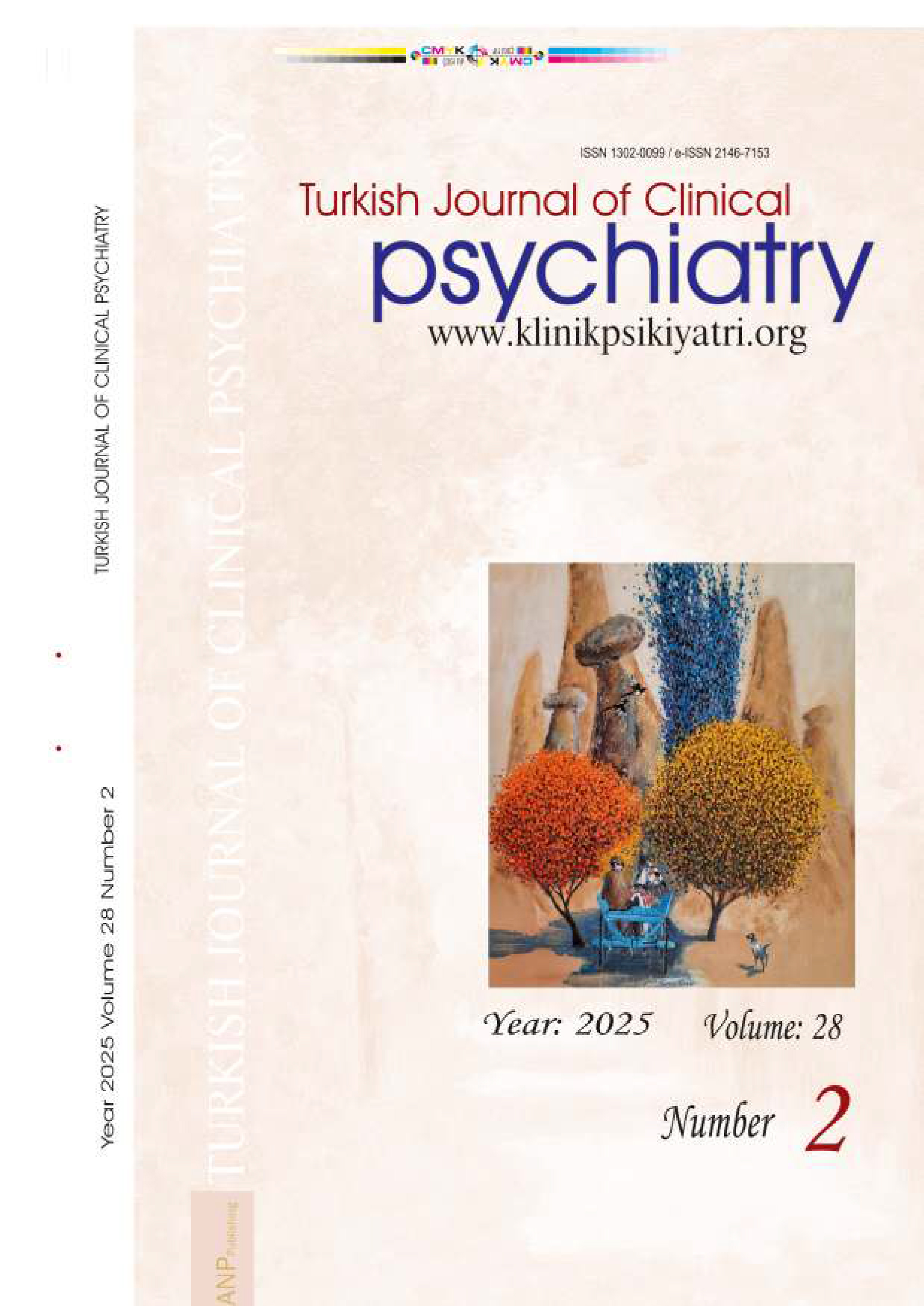





Volume: 27 Issue: 4 - 2024
| EDITORIAL | |
| 1. | Is freedom and peace possible? Gamze Ozcurumez Bilgili doi: 10.5505/kpd.2024.89757 Pages 259 - 262 |
| RESEARCH ARTICLE | |
| 2. | Evaluation of intimate partner violence victims and perpetrators: A sample from Turkey Omer Tokgozlu, Kerem Sehlikoglu, Turgay Bork, Abdurrahim Turkoglu doi: 10.5505/kpd.2024.47529 Pages 263 - 272 INTRODUCTION: Intimate partner violence (IPV) refers to behaviours such as physical, psychological or sexual harm that occur in close or romantic relationships. The main objectives of this study are to describe the characteristics of IPV victims and perpetrators in Turkey, to elucidate the causes and risk factors associated with IPV, and to discuss the data obtained with similar studies. METHODS: The study population comprised IPV cases who had consented to participate between February 2019 and June 2020 in the emergency department and forensic medicine clinic. The study was prospective and informed consent was obtained from people who wanted to participate. The IPV victims' medical records were recorded on a questionnaire form prepared by the researchers. RESULTS: 311 cases were prospectively reviewed. Among the victims of violence, 277 (89.1%) were female and 34 (10.9%) were male. Physical violence emerged as the primary manifestation of IPV, accounting for 98.4% of reported incidents between partners. Jealousy (38.6%) and economic factors (37.6%) were identified as the most common triggers. Of the victims, 204 (65.6%) cases acknowledge this circumstance when exposed to IPV. As the level of education of the victim increases, violence due to jealousy and family factors was observed. The rate of exposure to economic violence was found to be high among women with low income levels. DISCUSSION AND CONCLUSION: It was thought that increasing the level of education of female victims of violence, promoting awareness of violence, fully integrating them into the workforce and thereby securing a sustainable economic income can significantly reduce the incidence of IPV and its acceptance. The study suggests that the widespread implementation of psychological support practices, including premarital education programmes and family counselling focused on addressing issues related to jealousy, holds the potential for substantial benefits in reducing IPV. |
| 3. | The effect of mental health literacy training given to primary care physicians on beliefs and attitudes towards mental illnesses: A randomized controlled trial Emel Guden, Arda Borlu, Ozlem Olguner Eker, Saliha Ozsoy, Zeynep Baykan doi: 10.5505/kpd.2024.28445 Pages 273 - 284 INTRODUCTION: The attitudes of primary care family physicians towards mental illnesses are crucial for the prevention and early detection of such disorders. This study aimed to assess the impact of mental health literacy education on the beliefs and attitudes of family physicians in Turkey regarding mental illnesses. METHODS: This study, conducted using a pre-test post-test experimental design with experimental and control groups, involved 461 physicians from 95 Family Health Centers in Kayseri, Turkey. Both experimental and control groups were administered pre-tests, followed by online mental health training for the experimental group, and then post-tests were conducted. Data were collected using the "Personal Information Form," "Mental Health Literacy Scale," "Beliefs toward Mental Illness Scale," and "Community Attitudes toward the Mentally Ill Scale." The effects of the intervention were evaluated using the Mann Whitney U Test, and correlation analysis was applied to assess the interrelations of the scales. RESULTS: Data from 184 physicians were analyzed, the educational intervention significantly improved mental health knowledge (p=0.032), help-seeking adequacy (p=0.043), and positive attitudes (p=0.032), while reducing perceptions of danger (p=0.043) among the intervention group. The study indicated significant enhancements in mental health knowledge and help-seeking adequacy among primary care physicians in Turkey following online mental health literacy education. However, its impact on beliefs and attitudes towards mental illness is comparatively modest. Further research is necessary for a deeper analysis of the relationships between these dimensions. DISCUSSION AND CONCLUSION: Mental health literacy education positively influences primary care physicians' knowledge and help-seeking behaviors regarding mental illnesses, although it has a relatively modest impact on their beliefs and attitudes. There is a need for further research to conduct a more in-depth analysis of the relationships between the dimensions of beliefs and attitudes towards mental illnesses in mental health literacy education. |
| 4. | Factors affecting quality of life and hopelessness levels of patients with intravitreal injection Esra Karabulut, Havva Gezgin Yazici, Saadet Gultekin Irgat doi: 10.5505/kpd.2024.36043 Pages 285 - 292 INTRODUCTION: This study aimed to analyse the quality of life, level of hopelessness and factors affecting patients receiving intravitreal injections. METHODS: This descriptive and cross-sectional study was conducted between 18.08.2022 and 10.10.2022 with 268 patients in Turkiye. Data were collected with the Personal Information Form, Beck Hopelessness Scale (BHS) and SF-36 Quality of Life Scale. T-test, one-way analysis of variance (ANOVA) and post hoc (Tukey, LSD) analyses were used to analyse the differences in scale levels according to the descriptive characteristics of the patients. RESULTS: 54.1% of the patients were receiving intravitreal injection treatment for diabetic retinopathy, 28.4% for age-related macular degeneration and 17.5% for branch retinal vein occlusion. The total mean BHS score was 11.45±2.71. Physical pain seems to affect the quality of life the most. DISCUSSION AND CONCLUSION: This is the first study investigating hopelessness and quality of life in intravitreal injection patients. Hopelessness level of the patients was moderate. The lowest quality of life was found in the emotional role subscale. Age, gender, occupation, educational status and reason for intraocular injections affect the quality of life. |
| 5. | Evaluation of the frequency and clinical features of comorbid adult separation anxiety disorder in patients with generalized anxiety disorder Meltem Pusuroglu, Cicek Hocaoglu doi: 10.5505/kpd.2024.72368 Pages 293 - 299 INTRODUCTION: The aim of this study is to examine the frequency and clinical features of comorbid Adult separation anxiety disorder (ASAD) in patients with generalized anxiety disorder (GAD). METHODS: A total of 80 patients with GAD according to DSM-5 were included in the study. All patients were administered the Sociodemographic Characteristics Form, the Separation Anxiety Symptom Inventory (SASI), the Beck Depression Inventory (BDI), the Beck Anxiety Inventory (BAI), and the Adult Separation Anxiety Symptom Questionnaire (ASA). Patients with GAD were grouped and compared as those with and without comorbid ASAD. RESULTS: Of the 80 patients diagnosed with GAD, 33 (41.3%) had comorbid ASAD. Age, depressive symptom level and ASAI score were found to be significantly related to anxiety level (β=0.328, p=0.001; β=0.273, p=0.007; β= 0.284, p=0.014, respectively). When the factors affecting the anxiety level are taken into consideration, a 1-unit increase in the age variable causes an increase of 0.013 units, a 1-unit increase in the depressive symptom level causes an increase of 0.013 units, and a 1-unit increase causes an increase of 0.013 units. It was found that ASA scores caused an increase of 0.008 units. DISCUSSION AND CONCLUSION: Questioning the diagnosis of ASAD during the diagnosis and treatment process of patients with GAD may affect the course of the illness. |
| 6. | Rapid tranquilization experiences of Turkish psychiatrists: A preliminary online survey Mehmet Unler, Irem Ekmekci Ertek doi: 10.5505/kpd.2024.53533 Pages 300 - 310 INTRODUCTION: Agitation corresponds to excessively verbal, and physical aggressive behaviors. When appropriate behavioral approaches fail to control agitation, rapid tranquilization can be used. Rapid tranquilization guidelines have been established in different countries but cannot always be adapted to clinical practice effectively. In this study, we aimed to determine the clinical experiences and preferences of Turkish psychiatrists regarding rapid tranquilization of acutely agitated individuals and to evaluate the variables affecting these approaches. METHODS: A cross-sectional online survey was conducted between November 2019 and March 2020. The survey link was mailed to a sample of 131 Turkish psychiatrists. A significant proportion of the study sample worked in academic institutions like universities. The questionnaire consisted of mostly single-choice questions about rapid tranquilization, the use of zuclopenthixol acetate, and experiences with intravenous haloperidol. RESULTS: Only 34.4% of the clinicians adhered to a guideline and almost half of the clinicians did not follow up with the patients after the rapid tranquilization. Intramuscular drug administration was preferred to a greater extent, and haloperidol was the most preferred first-line agent. Simultaneous anticholinergic administration was an almost established practice. The most preferred use of zuclopenthixol acetate was sedation whereas intravenous haloperidol was applied most frequently for delirium. DISCUSSION AND CONCLUSION: In Turkey, mental health resources are still limited. Moreover, some pharmacological agents or different administration forms are not available. These difficulties seem to increase improper use of rapid tranquilization approaches. A national consensus text is needed and clinicians should be invited to periodic courses. Since the study's sample tends to be clustered in certain institutions, the findings should be evaluated with caution refraining from overgeneralization. |
| 7. | Attitudes of health care professionals towards violence against women: Are mental health professionals more sensitive? Selin Balki Tekin, Rabia Melis Gundogan, Osman Zulkif Topak doi: 10.5505/kpd.2024.34270 Pages 311 - 319 INTRODUCTION: Mental health professionals have greater access to information about patients' personal lives compared to other areas of medicine. The purpose of our study was to evaluate the attitudes of mental health professionals and other healthcare professionals towards violence against women. METHODS: A total of 160 healthcare professionals, including 80 mental health professionals, participated in the study. All participants completed a sociodemographic data form and the Violence Against Women Attitude Scale. RESULTS: The sociodemographic characteristics of the groups were similar (p>0.05). It was found that 63.8% of the participants had experienced violence at some point in their lives, with 45.2% experiencing violence from family members or spouses, 31.7% from their patients or patients’ relatives, and 25% experiencing physical violence, 51.3% emotional violence, 3% sexual violence and 4% economic violence. No significant differences were found between the groups. Additionally, there was no significant difference in attitudes towards violence against women between mental health professionals and other healthcare professionals. It was also discovered that university graduates, single women, women without children, women living in urban areas, women who were not perpetrators of violence, and women who did not find the penalties adequate were more sensitive to violence against both the body and identity (p<0.05). Furthermore, women who had previously experienced emotional violence were more sensitive to violence against identity (p=0.019). DISCUSSION AND CONCLUSION: Establishing the attitudes of healthcare professionals, who serve as the primary defense against violence against women, and furnishing in-service training to equip them with the ability to guide victims of violence effectively is a vital action in the struggle against violence. |
| 8. | Risk factors associated with disease severity in autism spectrum disorder Duygu Karagoz, Nilfer Sahin, Raziye Ulku Kicali doi: 10.5505/kpd.2024.57702 Pages 320 - 330 INTRODUCTION: This study aimed to evaluate prenatal-perinatal-postnatal risk factors, which are thought to have a role in the etiology of autism spectrum disorder, according to autism severity and to evaluate the relationship between maternal stress during pregnancy and the age difference between parents. METHODS: 100 children between the ages of 18-72 months who were diagnosed with ASD according to DSM-V diagnostic criteria and were followed up were included in the study. By evaluating the clinical severity of autism with the childhood autism rating scale, children diagnosed with ASD were divided into two subgroups according to clinical severity. Sociodemographic data and risk factors were recorded in the clinical data form, and the characteristics of the two groups were compared. Birtchnell Spouse Evaluation Scale-female form was applied to mothers to evaluate marital-relationship problems. RESULTS: In our study, it was determined that premature birth and regression history were more common in the severe autism group than in the mild-moderate autism group (p=0.007, p=0.025). No significant relationship was found between the difference between the ages of the mother and father and the subscales of the Birtchnell Spouse Rating Scale. It was found that the disconnection subscale of the Birtchnell Spouse Assessment Scale was significantly higher in the severe autism group. DISCUSSION AND CONCLUSION: Our study is one of the few studies conducted in this field and aims to contribute to the identification of preventable risk factors of autism. In the future, there is a need to confirm the data with larger studies in which maternal stress risk factors are also evaluated in the postnatal period and include other maternal stress factors besides marriage-relationship problems. |
| CASE REPORT | |
| 9. | Diagnostic conundrum: A rare case of psychosis in leptospirosis among siblings with folie à trois Tengku Mohd Saifuddin Tengku Kamarulbahri, Rosliza Yahaya doi: 10.5505/kpd.2024.87528 Pages 331 - 334 Folie à Trois is a rare presentation of psychosis. It has been described in several case reports, but there is a lack of studies to understand the mechanism and management of this disease. We presented a case of three siblings who share the same delusional idea initially induced by one of the sisters who had neuropsychiatric manifestations of leptospirosis. The siblings exhibited a shared pattern of aggressive behaviors, auditory hallucinations, and persecutory delusions toward each other. Intriguingly, two of the sisters displayed improvement even without pharmacological intervention. The case highlights the complexity of differentiating shared psychotic disorder from organic etiologies, emphasizing the importance of multidisciplinary assessments in unraveling intricate clinical presentations. The distinctive temporal resolution of psychiatric symptoms among the siblings underscores the need for nuanced diagnostic considerations in shared psychotic disorders. This case report contributes to the understanding of the interplay between infectious diseases and psychiatric manifestations, urging clinicians to exercise meticulous scrutiny in cases of shared psychotic disorders masquerading as organic illnesses. |










